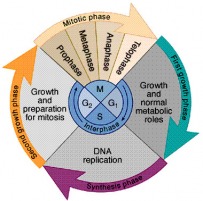The Cell Cycle
Just as the organism as a whole, cells go through a kind of life cycle called the cell cycle. This cycle is comprised of the controlled sequence of growth and division of a cell.
The cell cycle is divided into two distinct phases, INTERPHASE, the longer phase comprised of G1, S, and G2; and MITOSIS, or M, when cell division occurs. The cell spends most of it's lifetime in Interphase, growing and carrying on metabolic processes, and copying DNA-containing chromosomes in preparation for cell division.
During G1, chromosomes are not visible under the light microscope because they are uncoiled. Protein synthesis is occuring and the cell grows rapidly. The S phase is significant for the replication of chromosomes in the form of chromatids. This replication is necessary for cell division. Identical sister chromatids are connected by a centromere. In G2, new proteins are produced, especially those needed to trigger mitosis. The cell continues to grow, centrioles replicate and prepare to form the mitotic spindle (see later discussion).
Now, please click on the following links to learn more about the cell cycle. Please remember to scroll down and/or click on icons to get more info at these sites.
www.cellsalive.com/cell_cycle.htm
www.712designs.com/animations/flash/cellCycle.swf
http://bio1100.nicerweb.com/med/Vid/Johnson4e/Anim/ch07/how_the_cell_cycle_work.swf

